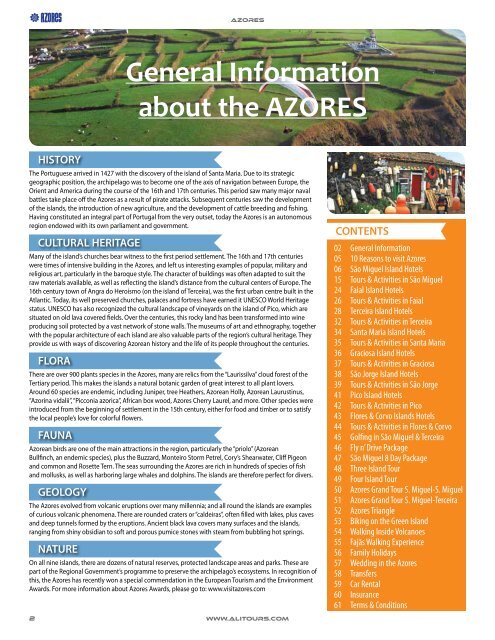Create successful ePaper yourself
Turn your PDF publications into a flip-book with our unique Google optimized e-Paper software.
2<br />
HISTORY<br />
AZORES<br />
The Portuguese arrived in 1427 with the discovery of the island of Santa Maria. Due to its strategic<br />
geographic position, the archipelago was to become one of the axis of navigation between Europe, the<br />
Orient and America during the course of the 16th and 17th centuries. This period saw many major naval<br />
battles take place off the <strong>Azores</strong> as a result of pirate attacks. Subsequent centuries saw the development<br />
of the islands, the introduction of new agriculture, and the development of cattle breeding and fishing.<br />
Having constituted an integral part of Portugal from the very outset, today the <strong>Azores</strong> is an autonomous<br />
region endowed with its own parliament and government.<br />
CULTURAL HERITAGE<br />
Many of the island’s churches bear witness to the first period settlement. The 16th and 17th centuries<br />
were times of intensive building in the <strong>Azores</strong>, and left us interesting examples of popular, military and<br />
religious art, particularly in the baroque style. The character of buildings was often adapted to suit the<br />
raw materials available, as well as reflecting the island’s distance from the cultural centers of Europe. The<br />
16th century town of Angra do Heroísmo (on the island of Terceira), was the first urban centre built in the<br />
Atlantic. Today, its well preserved churches, palaces and fortress have earned it UNESCO World Heritage<br />
status. UNESCO has also recognized the cultural landscape of vineyards on the island of Pico, which are<br />
situated on old lava covered fields. Over the centuries, this rocky land has been transformed into wine<br />
producing soil protected by a vast network of stone walls. The museums of art and ethnography, together<br />
with the popular architecture of each island are also valuable parts of the region’s cultural heritage. They<br />
provide us with ways of discovering Azorean history and the life of its people throughout the centuries.<br />
FLORA<br />
There are over 900 plants species in the <strong>Azores</strong>, many are relics from the “Laurissilva” cloud forest of the<br />
Tertiary period. This makes the islands a natural botanic garden of great interest to all plant lovers.<br />
Around 60 species are endemic, including Juniper, tree Heathers, Azorean Holly, Azorean Laurustinus,<br />
“Azorina vidalii”, “Picconia azorica”, African box wood, <strong>Azores</strong> Cherry Laurel, and more. Other species were<br />
introduced from the beginning of settlement in the 15th century, either for food and timber or to satisfy<br />
the local people’s love for colorful flowers.<br />
FAUNA<br />
Azorean birds are one of the main attractions in the region, particularly the “priolo” (Azorean<br />
Bullfinch, an endemic species), plus the Buzzard, Monteiro Storm Petrel, Cory’s Shearwater, Cliff Pigeon<br />
and common and Rosette Tern. The seas surrounding the <strong>Azores</strong> are rich in hundreds of species of fish<br />
and mollusks, as well as harboring large whales and dolphins. The islands are therefore perfect for divers.<br />
GEOLOGY<br />
The <strong>Azores</strong> evolved from volcanic eruptions over many millennia; and all round the islands are examples<br />
of curious volcanic phenomena. There are rounded craters or “caldeiras”, often filled with lakes, plus caves<br />
and deep tunnels formed by the eruptions. Ancient black lava covers many surfaces and the islands,<br />
ranging from shiny obsidian to soft and porous pumice stones with steam from bubbling hot springs.<br />
NATURE<br />
General Information<br />
about the AZORES<br />
On all nine islands, there are dozens of natural reserves, protected landscape areas and parks. These are<br />
part of the Regional Government’s programme to preserve the archipelago’s ecosystems. In recognition of<br />
this, the <strong>Azores</strong> has recently won a special commendation in the European Tourism and the Environment<br />
Awards. For more information about <strong>Azores</strong> Awards, please go to: www.visitazores.com<br />
WWW.ALITOURS.COM<br />
CONTENTS<br />
02 General Information<br />
05 10 Reasons to visit <strong>Azores</strong><br />
06 São Miguel Island Hotels<br />
15 Tours & Activities in São Miguel<br />
24 Faial Island Hotels<br />
26 Tours & Activities in Faial<br />
28 Terceira Island Hotels<br />
32 Tours & Activities in Terceira<br />
34 Santa Maria Island Hotels<br />
35 Tours & Activities in Santa Maria<br />
36 Graciosa Island Hotels<br />
37 Tours & Activities in Graciosa<br />
38 São Jorge Island Hotels<br />
39 Tours & Activities in São Jorge<br />
41 Pico Island Hotels<br />
42 Tours & Activities in Pico<br />
43 Flores & Corvo Islands Hotels<br />
44 Tours & Activities in Flores & Corvo<br />
45 Golfing in São Miguel & Terceira<br />
46 Fly n’ Drive Package<br />
47 São Miguel 8 Day Package<br />
48 Three Island Tour<br />
49 Four Island Tour<br />
50 <strong>Azores</strong> Grand Tour S. Miguel-S. Miguel<br />
51 <strong>Azores</strong> Grand Tour S. Miguel-Terceira<br />
52 <strong>Azores</strong> Triangle<br />
53 Biking on the Green Island<br />
54 Walking Inside Volcanoes<br />
55 Fajãs Walking Experience<br />
56 Family Holidays<br />
57 Wedding in the <strong>Azores</strong><br />
58 Transfers<br />
59 Car Rental<br />
60 Insurance<br />
61 Terms & Conditions


